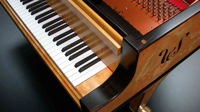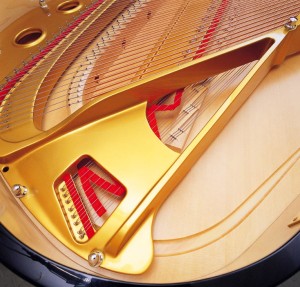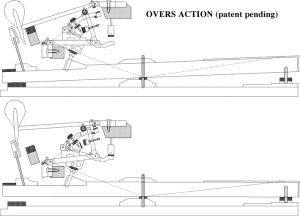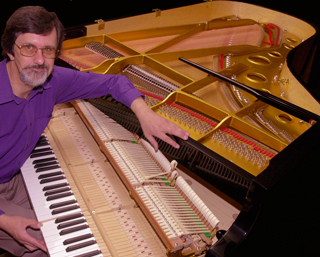
My understanding of the relationship between pianists and the pianos they play has been influenced by an event a few years back. Offered a choice between an ailing specimen of a leading European marque (an old instrument in extremely poor condition, weak in tone, and obviously in need of restoration) and a leading Asian brand in excellent working order (well regulated, with a strong, attractive sound), I witnessed a fellow student make a curious selection. Inquiring afterwards, I was told that a teacher had given an instruction to always choose the European make.
Clearly, the cachet of a label can have a significant effect on a pianist’s perception of what they are playing. In this light, it is interesting to view attitudes regarding acceptance of Australian-built pianos today.
Ron Overs is Australia’s ‘other’ piano builder. While not yet having the success or exposure of Wayne Stuart, Overs has been developing his craft from a small workspace in the inner western suburbs of Sydney for the past 33 years. His ideas for piano design have developed through rebuilding existing instruments, with key focuses on soundboard design and the internal mechanism, the “action”.
Since the late 1990s, Overs has used an all-maple hardwood Klaus Fenner 225 cm case, manufactured to specification in Korea, to build instruments implementing his designs. To date, six mid-size 7’4” grand pianos have been built, each developing further on the experiences of previous builds.
My first encounter with a piano built by Ron Overs was in 2001. I had already developed an interest in Australian pianos, giving the first public performance on Stuart’s no. 4 instrument (the ‘Powerhouse’) in a live broadcast on ABC Classic FM, and playing his pianos in promotions during the Sydney Olympics.

While personally finding Stuart pianos well-suited to French music, such as Ravel and Debussy, I was immediately aware that Overs’ pianos had strengths in areas suitable for a wide range of repertoire. As the work was being prepared for performance at the time, I spent a couple of hours playing Rachmaninoff’s Third Piano Concerto on Overs’ no. 3 piano in his studio – a fitting piece of music, perhaps, for exploring a piano’s extremes. Considering the size of the instrument, it produced both a quantity and quality of sound more usually associated with a full-size concert grand. Along with a rich, dark tone, it made light of Rachmaninoff’s typically dense passage work.


I was offered the use of this instrument for a CD the following year (Lilacs, ABC Classics), recorded in the Music Workshop of the Sydney Conservatorium of Music, where its tone was captured well. The quality of its sound had a significant impact on my interpretation of the music, and on this issue I feel it is important to be specific: pianists I admire are rarely those who replicate in performance the interpretation they have developed at home; rather, those I hold in highest regard are those who create a performance reflecting the hall, the occasion, the audience and – almost uniquely for pianists – the instrument on the stage. In this regard, a piano might be compared to an artist’s palette, and I found the Overs no. 3 piano to be almost limitless in its tones and shades. In all respects, it was a truly inspiring instrument.
Ron Overs patented his design for a piano action in 2000, articulating his desire for a higher level of mechanical efficiency. As a fundamental aspect of his design, less friction is produced in the way the finger sends the hammer toward the strings. His design both increases the capacity of the mechanism and results in greater amenity for technicians servicing his instruments. Furthermore, his actions have required less regulatory work in maintaining function at optimal levels. One consequence of his design has been a faster return rate of the key, an issue which a few pianists have noted negatively. I must admit, however, to having not noticed any difference. As with many aspects of Overs’ work, elements of his design are developing further, and this in itself interests me: a truly innovative builder, his ability to adapt and modify his designs, and to constructively take feedback from pianists and technicians, means that his instruments continue to evolve.
Results of this approach were evident in Overs’ no. 5 piano, which I was able to use for a second CD for ABC Classics, Pictures From An Exhibition, in 2004. In this instrument, some important principles for new soundboard design were established, including the strengthening of his board with I-section ribs, and the utilisation of laminated curved beams to modify the active soundboard area. Through these measures, Overs produced a piano with an extraordinarily clean, ‘pure’ sound. Coupled with advances in scale design – details of which relate to the placement of the bridges and the point where the wire and copper-wound bass strings cross – an even greater uniformity in the quality of sound from the highest notes to the lowest on the keyboard was achieved. I was delighted to use this piano in a chamber music concert a few years back, where its fine qualities were most evident in a performance of Shostakovich’s Second Piano Trio. The growling sotto voce statements of the fourth movement theme in the extreme bass of the piano projected with utmost ease, and, despite the instrument’s manifest power, the string instruments were not overwhelmed in the loud climactic sections; this is due, I believe, to its clarity of sound.
Indeed, the power of Overs’ pianos has been a hallmark characteristic to date. My greatest hope has been to see Ron in a position where he is able to put his designs for other instruments into production. For example, detailed drawings for his 9’ piano have existed for a number of years. Although it is disappointing to acknowledge, it is clear that some will only give Overs serious consideration when a full-size concert grand piano has been produced. Local companies have been selected for casting frames and producing the case-work, yet a potential buyer has so far not eventuated. Given the strength of his midsized grands – which when played side-by-side with full-size instruments often outperform them – I find it tantalising to consider how well his 9’ design might negotiate the demands of matching a large orchestra in concerto repertoire. It’s a pity one of our orchestras isn’t willing to explore this possibility!
Overs has also designed a particularly innovative upright piano. In his design, a new ironplate structure allows the string scale to be reduced down to only two sections, treble and bass. Providing structural solutions to endemic upright piano problems, the new design also allows for a continuous full-height treble bridge, and middle and bass register strings of lengths comparable to a typical 6’ grand piano. As a result, the Overs 131 model will have tonal qualities similar to a grand, and an increased level of tuning stability due to the greater uniformity of string tension across the frame. A prototype of this piano will be built in 2010.
I feel it is important to briefly assess the issue of viability in piano design and manufacture. Significantly, demand for upright and grand pianos – both for domestic and professional use – remains strong, not only here but in the constantly expanding Asian market. In regard to local tastes, however, we appear still to be impeded by cultural prejudices in ways similar to my earlier anecdote. And this seems a great pity. The Overs no. 5 piano, which is owned by the Sydney Conservatorium of Music, is housed in the West Recital Hall and has been subjected to almost constant use over the past four years.
It has proved extremely popular with students and staff, it has outstanding tuning stability when compared with other instruments, and has been kept in good running order with minimum effort. Given these attributes, it is an ideal studio piano. Yet Australian music institutions continue to purchase vast stocks of European and Asian instruments. I don’t deny for a moment that these leading brands provide important international benchmarking for institutions, but could there not be room for a little more support for a piano such as this, especially when suitability has been proven?
In his days as a travelling virtuoso, it is said that Franz Liszt would inquire of each new town the names of local piano builders and, as a matter of principle, seek to use one of their instruments in his performance. In doing this there is clearly an inquisitiveness, and a desire to seek out diversity in different styles and sounds of pianos. In an age when most piano manufacturers have settled on copying an almost identical piano sound, might we be losing some of that diversity? And our inquisitiveness, too? We should be grateful for the tenacity of our Australian piano builders, and I hope we can collectively ensure they receive the support they need.
Scott Davie, November 2009

Leave a Reply